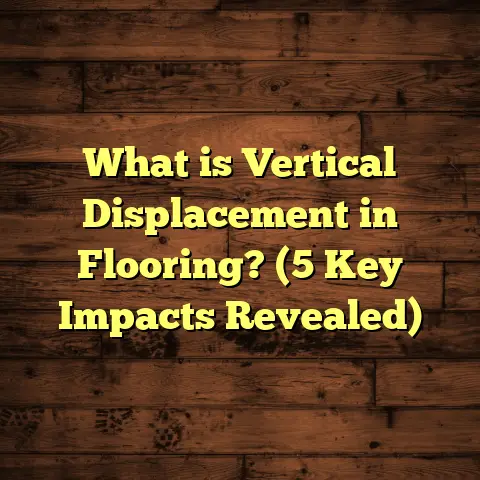What is the Preferred Thickness for Vinyl Plank Flooring? (5 Tips for Choosing the Best Option)
I still remember the first time I stepped into a newly renovated kitchen with vinyl plank flooring.
The floors were smooth, warm, and surprisingly solid underfoot.
I found myself wondering why some vinyl plank floors felt so different from others I’d seen before.
The secret was in the thickness of the planks, and that little detail can make or break your flooring experience.
If you’ve ever asked yourself, “What thickness should my vinyl plank flooring be?” or
wondered how to choose the best option for your home or business, I’m here to walk you through everything.
Over years of flooring projects and research, I’ve gathered insights that go beyond the basics.
Let’s talk about vinyl plank flooring thickness in a way that’s easy to understand—and useful.
What Exactly Is Vinyl Plank Flooring Thickness?
Vinyl plank flooring thickness is the overall height of one plank, measured from its bottom backing layer to the very top wear layer.
This number is usually expressed in millimeters (mm) or sometimes inches.
The thickness includes several layers stacked together:
- Wear Layer: The clear, protective top layer that guards against scratches, stains, and dents.
- Vinyl Core: The main body of the plank, which gives structure and stability. This can be made of different materials like WPC (wood plastic composite) or SPC (stone plastic composite).
- Backing Layer: The bottom layer that provides balance and moisture resistance.
Think of it like a sandwich—the thickness is the total height of all the layers combined.
Why Thickness Matters
At first glance, you might think a thinner plank is just cheaper or easier to install.
But thickness impacts many aspects: comfort when you walk on it, how much noise it absorbs, how well it hides imperfections in your subfloor, and how long it lasts.
A thicker plank generally feels more solid and comfortable underfoot.
It also tends to be more durable—especially if the wear layer is thick as well.
But there are trade-offs, like cost and installation considerations.
Thickness Ranges You’ll Encounter
Vinyl plank flooring varies widely in thickness from about 2 mm (0.08 inches) up to 8 mm (0.31 inches) or more.
Here’s a quick overview:
- Thin Options (2-3 mm): These are usually entry-level planks. They’re flexible and sometimes used for temporary or low-traffic areas.
- Mid-range Options (4-5 mm): This is where most residential vinyl plank flooring falls. It offers a good balance between durability and cost.
- Thicker Options (6-8+ mm): These planks often come with enhanced cores like SPC or WPC and thicker wear layers. They’re meant for heavy traffic areas or commercial settings.
How Thickness Affects Performance: My Observations
Over the years, I’ve worked with all sorts of vinyl planks across different thicknesses.
Here’s what I’ve noticed firsthand:
- Comfort: Thicker planks feel softer and warmer underfoot. I installed 7 mm SPC vinyl in a client’s living room, and they loved how it felt compared to their previous tile floor, which was cold and hard.
- Durability: Thicker planks with solid wear layers handle scratches and dents better. In a restaurant project, we replaced thin vinyl planks after just six months because they showed heavy wear; upgrading to 6 mm SPC solved the problem for years.
- Sound Absorption: Thicker planks reduce echo and footstep noise—a big win for condos or apartments where sound travel is a concern.
- Installation: Thick planks can sometimes be trickier to cut but often compensate by hiding minor subfloor bumps better without telegraphing them through.
Wear Layer Thickness: Why It’s Just as Important
Let me clarify something many people miss: the total plank thickness isn’t the whole story.
The wear layer—the protective top coat—is critical for long-term performance.
Wear layers vary from 6 mil (0.15 mm) up to 40 mil (1 mm) in luxury products.
Here’s what I’ve learned about wear layers:
- A thicker wear layer means better resistance to scratches, stains, and general wear.
- For homes with kids or pets, aim for at least 20 mil wear layer thickness to handle rough use.
- Commercial spaces often require 28 mil or higher for durability.
In one project with a client who had three dogs, we chose a 5 mm plank with a 30 mil wear layer. Six months later, their floors still looked great despite all the paw traffic.
Tip #1: Match Thickness to Your Room’s Traffic Level
Different rooms get different amounts of traffic—and your vinyl plank thickness should reflect that.
- High Traffic Areas: Kitchens, hallways, living rooms—go for 5 mm or thicker with a strong wear layer. These areas get heavy foot traffic daily and need extra durability.
- Medium Traffic Areas: Bedrooms or offices can handle slightly thinner planks, around 3-4 mm.
- Low Traffic or Temporary Spaces: Closets or guest rooms might be fine with thinner options if budget is tight.
I once installed 3 mm planks in a guest bedroom; they worked perfectly since it’s rarely used. But for the family room? Definitely thicker options.
Tip #2: Think About Your Subfloor Condition
This one trips up many homeowners!
If your subfloor isn’t perfectly smooth—maybe it’s an older concrete slab or plywood with some unevenness—thicker vinyl planks will mask those imperfections better.
I had a client with an old basement where leveling was cost-prohibitive. Choosing 6 mm thick vinyl planks helped minimize visible bumps without expensive repairs.
If you have a brand-new, smooth subfloor, you can opt for thinner planks without worrying about dips showing through.
Tip #3: Choose the Right Core Material Along With Thickness
Not all vinyl cores are created equal.
There are three main types:
- Traditional Vinyl Core: Thin and flexible but less durable. Usually found in thinner planks.
- WPC (Wood Plastic Composite): Thicker and softer; provides some cushion underfoot.
- SPC (Stone Plastic Composite): Denser and more rigid; excellent durability and moisture resistance.
SPC cores add density and strength, often pushing total plank thickness above 5 mm. WPC cores add comfort but may be less durable in commercial spaces.
From my experience, SPC is ideal for kitchens, bathrooms, and commercial floors due to moisture resistance. WPC works well in living areas where comfort matters more.
Tip #4: Balance Budget Against Long-Term Value
I get it—cost matters! But here’s a little truth from my projects:
Spending a bit more on thicker vinyl plank flooring upfront usually pays off down the line through longer lifespan and fewer repairs/replacements.
Here’s some pricing info based on recent projects:
| Thickness | Average Cost per Sq.Ft. | Best Use |
|---|---|---|
| 2 – 3 mm | $2 – $3 | Temporary/low traffic |
| 4 – 5 mm | $3 – $5 | Most residential rooms |
| 6 – 8 mm | $5 – $8+ | High traffic/commercial |
For example, one client saved $1 per square foot by choosing 3 mm thin planks, but ended up replacing them after two years due to damage, costing more overall than if they’d picked thicker planks initially.
Tip #5: Don’t Forget Installation Considerations
Thickness affects installation too!
Thicker planks might be harder to cut cleanly especially if you’re using hand tools. They also raise the floor height slightly—which matters if you have thresholds or door clearances.
If you’re installing over radiant heating, thinner planks may perform better because they transfer heat more efficiently.
I’ve seen DIYers struggle with cutting thick vinyl plank flooring without proper tools, so if you’re going this route, make sure you have a sharp utility knife or consider professional installation.
Real-Life Case Study: Family Room Renovation
A couple of years ago, I helped a family replace their worn-out carpet in their living room with vinyl plank flooring. They were debating between 3 mm thin planks vs. thicker 6 mm SPC options.
After walking them through pros and cons, we settled on 6 mm SPC with a 30 mil wear layer.
The family loves how warm the floor feels compared to tile or laminate, and their kids’ toys sliding across didn’t scratch it at all. After over two years, the floor still looks brand new despite heavy use—a clear win in my book.
Extra Factors That Influence Thickness Choice
Beyond just room type and wear layer, other things can affect what thickness works best:
Moisture Levels
If your space is humid or prone to moisture (basements, bathrooms), SPC cores with thicker planks resist water better than thinner traditional vinyl floors.
Soundproofing Needs
Thicker planks help reduce noise transmission—a bonus if you live in an apartment or have upstairs neighbors.
Style Preferences
Some ultra-thin vinyl planks offer sleek modern looks but sacrifice cushioning. Thicker options feel more substantial but may look slightly bulkier depending on design.
Common Myths About Vinyl Plank Thickness
Let me clear up some common misconceptions I hear:
Myth #1: Thicker always means better quality.
Truth: Thickness helps but only if combined with a good-quality core and wear layer.
Myth #2: Thin vinyl planks won’t last at all.
Truth: Some thin luxury vinyl options have strong wear layers suitable for low traffic areas.
Myth #3: You can’t install thick vinyl flooring over existing floors.
Truth: You can install over many existing floors as long as height differences are managed properly.
What About Thickness vs. Other Flooring Types?
Vinyl plank flooring thickness tends to be less than hardwood or laminate flooring but offers other benefits like water resistance and flexibility.
For instance:
| Flooring Type | Typical Thickness | Water Resistance | Durability |
|---|---|---|---|
| Vinyl Plank | 2 – 8 mm | High | Good (with wear layer) |
| Laminate | 7 – 12 mm | Low | Moderate |
| Hardwood | 18 – 20 mm | Low | High |
Vinyl is often thinner but can outperform laminate in wet areas due to its waterproof core options.
Final Thoughts on Choosing Vinyl Plank Thickness
If I had to summarize everything into one piece of advice:
Aim for at least 4-5 mm thick vinyl plank flooring with a good wear layer for most home areas.
This gives you durability without breaking the bank and covers most needs well.
For heavy use areas or commercial spaces, push toward 6-8 mm thick SPC vinyl with wear layers above 20 mil for long-lasting results.
Always think about where you’re installing the floor, your subfloor condition, and your budget before making a final choice.
Got More Questions? Let’s Talk Flooring!
Choosing the right vinyl plank thickness isn’t always straightforward. Every home and project has unique needs. If you want help figuring out what thickness suits your space best, just ask! I’m here to share what I’ve learned from years on the job and help you make a smart decision.
What kind of project are you working on?
I hope this detailed guide sheds light on why thickness matters so much in vinyl plank flooring—and helps you pick the perfect floor for your space!





